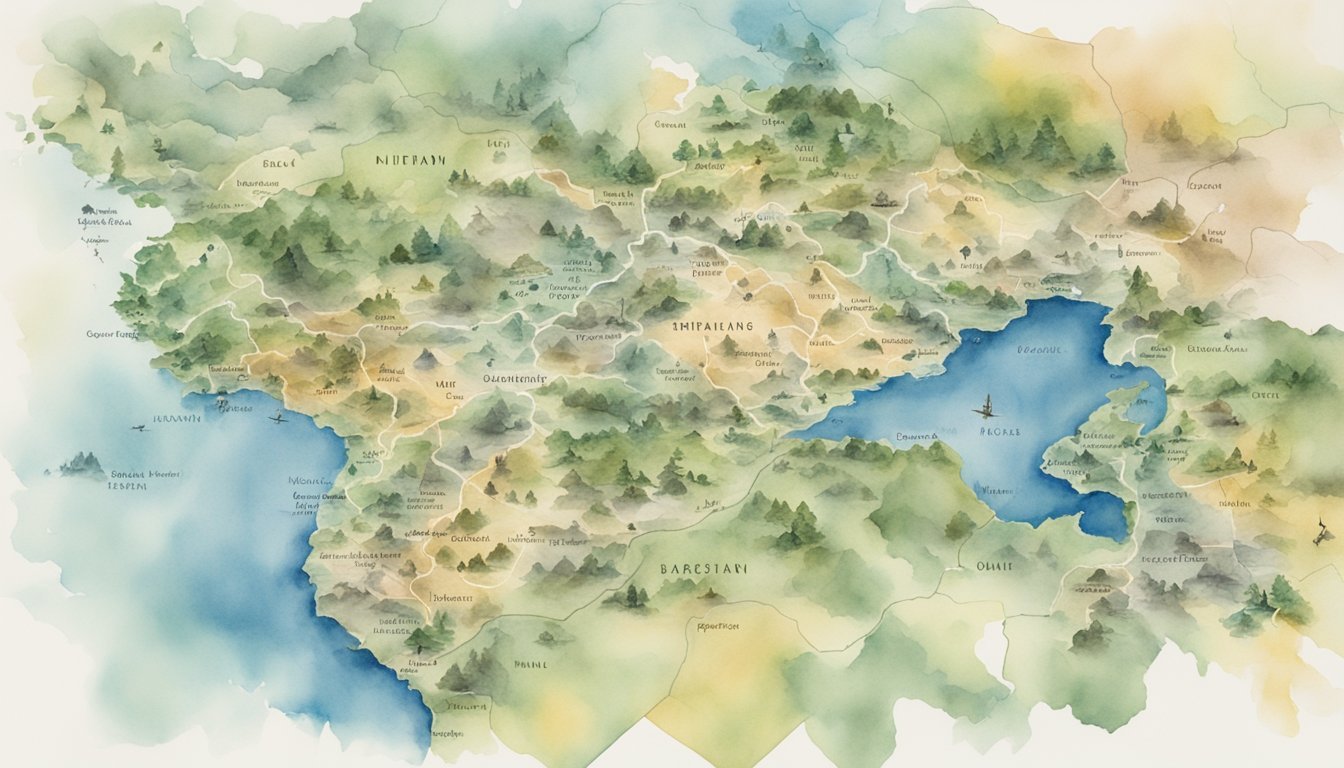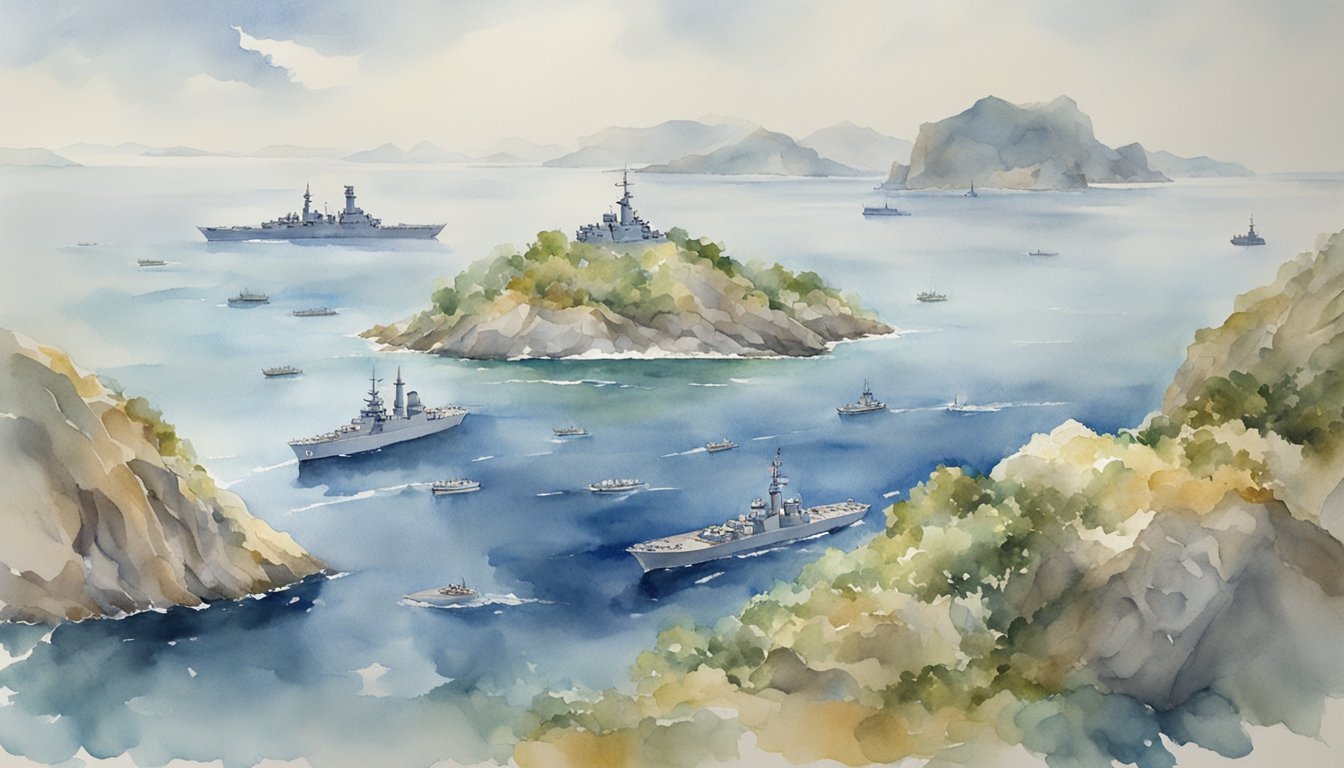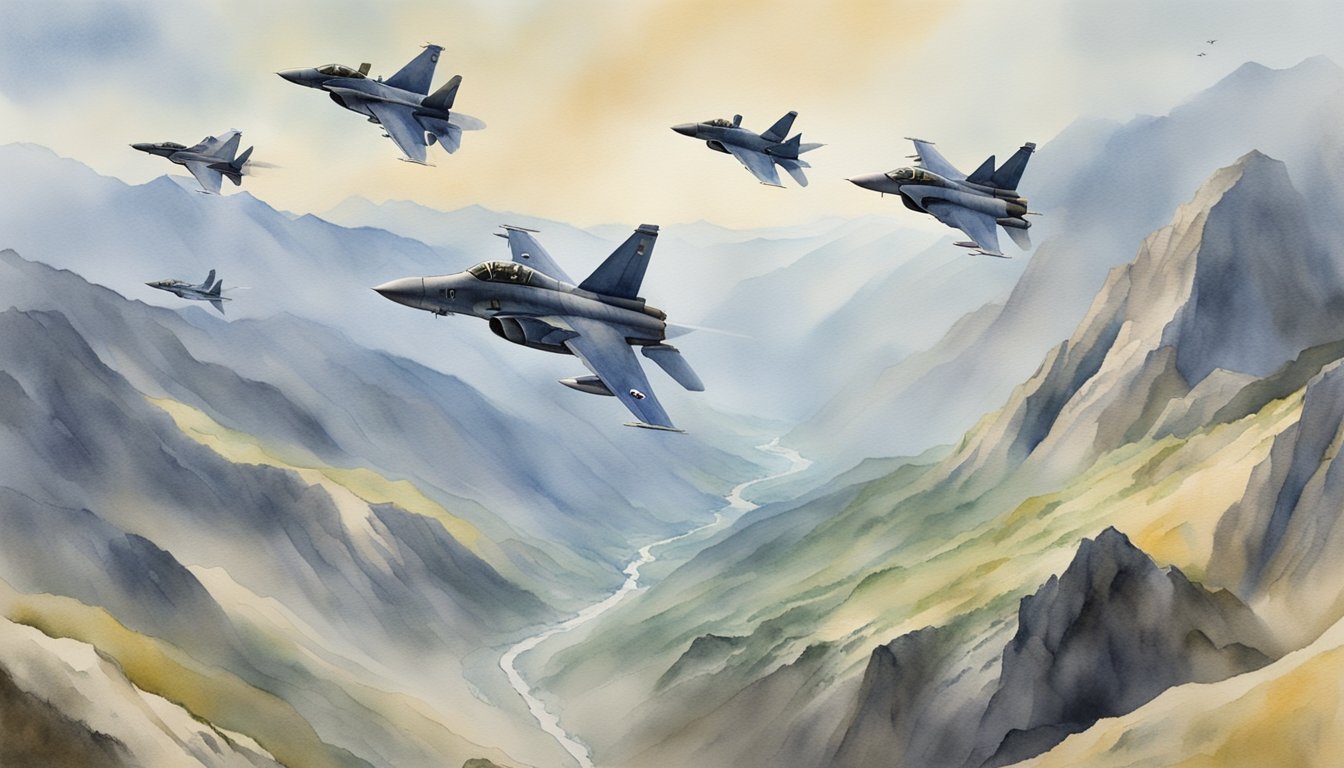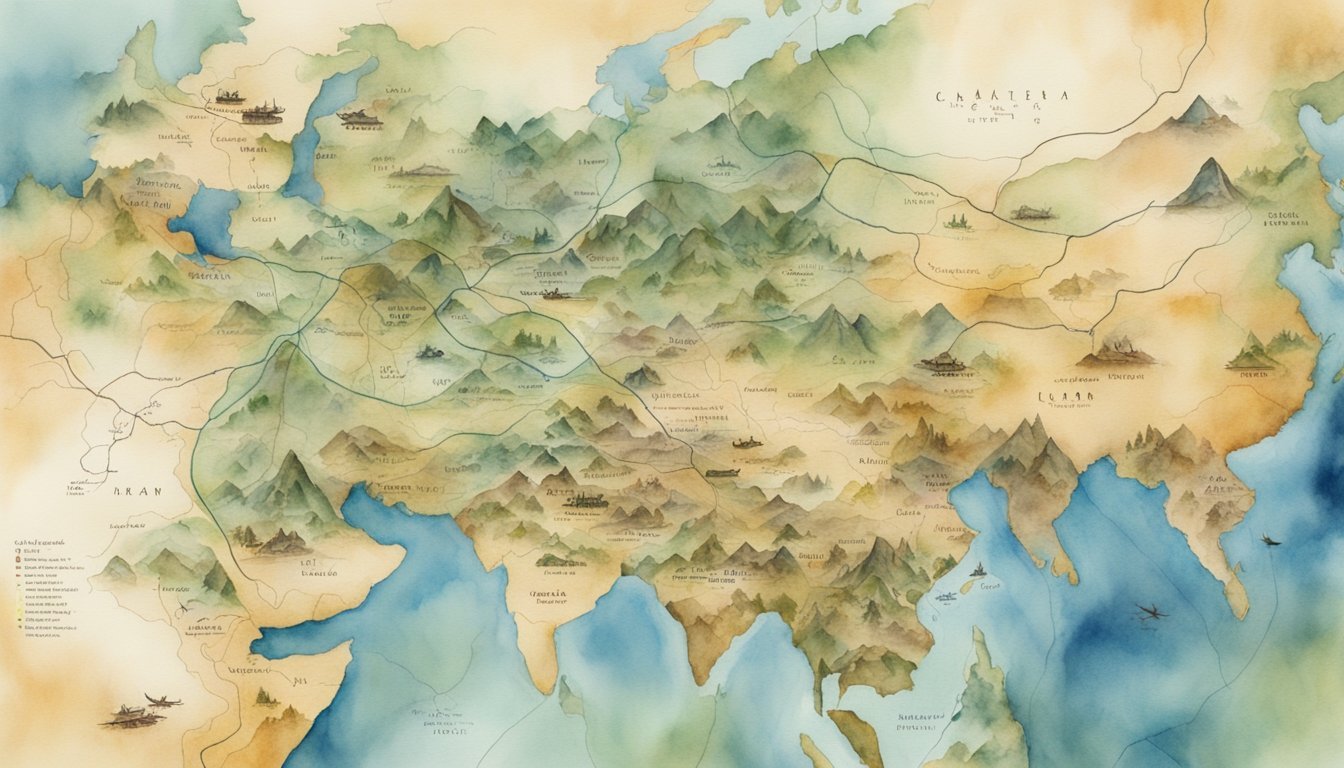The Influence of Geography on Military Operations: Strategic Impacts and Tactical Considerations

Geography has always played a crucial role in shaping military operations.
From commanding high ground to navigating vast oceans, understanding the terrain can make the difference between victory and defeat.
Military leaders have to consider mountains, rivers, deserts, and urban areas when planning their strategies to ensure success.

Throughout history, armies have used geographic knowledge to their advantage, whether by defending natural chokepoints or leveraging local weather patterns for surprise attacks.
Modern technology has enhanced this understanding, but the principles remain the same.
Geographic elements continue to influence political and military decisions on a global scale, affecting everything from troop movements to supply lines.
In today’s world, military operations must account for diverse environments such as megacities and remote regions.
The complexity of urban warfare and the strategic importance of maritime and aerial geography underscore the need for detailed terrain analysis.
By appreciating the link between geography and military strategy, you gain insight into how battles are won and lost.
Key Takeaways
- Geography is essential for military success.
- Terrain analysis impacts planning and outcomes.
- Modern warfare includes urban and remote areas.
Historical Context of Geography in Warfare

Geography has always played a crucial role in warfare, shaping battle strategies and outcomes throughout history.
From ancient times to the Cold War, the terrain and physical landscape have significantly influenced military operations.
Influence of Geography on Ancient and Medieval Battles
In ancient battles, geography determined the success of many campaigns.
For example, in the Battle of Thermopylae, the narrow pass between the cliffs and the sea allowed the vastly outnumbered Greek forces to hold off the Persian army for several days.
This terrain advantage was crucial.
Medieval battles also showcased the importance of geography.
Castles were commonly built on hills or surrounded by moats to make them harder to attack.
The Battle of Agincourt is another example, where the soft, muddy ground hindered the French knights, giving the English archers a significant advantage.
These instances illustrate how terrain and location were pivotal in historical military strategies.
Geography’s Role in the World Wars
World War I and World War II demonstrated the continued importance of geography in warfare.
In World War I, the trench warfare on the Western Front was heavily influenced by the landscape.
The rugged, varied terrain led to the construction of extensive trench networks, which defined the nature of the combat.
In World War II, the geography of Europe played a key role.
The invasion of Normandy (D-Day) required careful planning due to the coastal defenses and rough waters.
Additionally, battles in North Africa hinged on control over desert regions, with supply lines often stretched thin across vast, barren landscapes.
The Pacific Theater had its own unique challenges, with island-hopping campaigns dictated by the need to secure strategically important locations.
The Cold War and Geography
The Cold War era saw geography influencing military strategy on a global scale.
The spread of nuclear weapons and the concept of mutually assured destruction made geographic considerations even more critical.
The Cuban Missile Crisis highlighted how proximity to major powers could escalate tensions rapidly.
During the Vietnam War, the dense jungles and difficult terrain made conventional warfare tactics less effective.
Similarly, in Afghanistan, the mountainous landscape provided significant challenges to Soviet forces, impacting their operations and supply routes.
These geographic factors often dictated the nature and outcome of Cold War conflicts, emphasizing the ongoing importance of terrain in military planning.
Terrain Analysis and Military Geoscience
Understanding terrain and the application of military geoscience is crucial for strategic planning and effective military operations.
This involves evaluating landscapes and utilizing advanced technologies to gain a tactical advantage.
Terrain Evaluation for Military Planning
You must assess the terrain thoroughly to create effective military plans.
Diverse landscapes like mountains, forests, and deserts, impact troop movement and tactics.
For example, Israel’s diverse physical geography requires different strategies for each type of terrain.
Military planners use terrain analysis to identify key features such as elevation, slope, and vegetation.
These factors influence decisions on positioning troops, establishing supply lines, and setting up defensive positions.
A detailed terrain evaluation helps anticipate and mitigate potential obstacles, ensuring better preparedness and strategic advantage.
Military Geology and GIS Technology
Military geology involves applying earth sciences to military needs like constructing bases, roads, and facilities. Military geoscience also extends to locating essential resources like water and minerals, which are vital for sustained operations.
Geographic Information Systems (GIS) technology has transformed military operations.
A GIS-based decision-tree model enables precise analysis and visualization of spatial data.
This technology aids in predicting enemy movements, planning logistics, and optimizing routes.
By using GIS, you can make informed, data-driven decisions that enhance operational efficiency and tactical planning.
Political and Diplomatic Considerations

Political and diplomatic considerations significantly shape military operations.
This includes how geography influences political strategy and the role of diplomacy in managing border disputes.
Geography’s Impact on Political Strategy
Geography plays a crucial role in shaping political strategies.
Leaders often consider geographical features such as mountains, rivers, and coastlines when planning military campaigns.
These features can serve as natural barriers that protect a country from invasions or act as strategic points for launching attacks.
For example, natural barriers like mountains can provide defensible positions that are hard for enemy forces to penetrate. Rivers often act as natural borders, making them essential in defensive planning.
Additionally, the location of key resources such as oil fields or mineral deposits can shift a country’s military focus to protect these assets.
This drives policymakers to align military strategies with geographical realities to maintain national security.
To illustrate, the presence of oil in the Middle East has significantly influenced the military strategies of various nations, leading to numerous conflicts and political alliances centered around these resources.
Diplomacy and Border Disputes
Border disputes often arise due to the strategic importance of certain geographical areas.
Diplomacy is key in resolving these issues and preventing them from escalating into military conflicts.
Effective diplomacy can lead to treaties and agreements that define borders clearly and avoid misunderstandings.
For instance, disputes in regions like Kashmir between India and Pakistan highlight the need for skilled diplomacy.
Both nations claim this territory due to its strategic and resource-rich importance.
Moreover, international organizations like the United Nations often play a role in mediating such disputes. Peacekeeping missions and diplomatic negotiations aim to establish and maintain peace in contentious areas.
In cases where diplomacy fails, the risk of military engagement increases, highlighting the necessity for continuous diplomatic dialogue to manage and resolve border conflicts.
Maintaining open communication channels ensures that disputes can be settled without resorting to force.
Climate and Environmental Factors
Climate and environmental conditions significantly affect how military operations are planned and executed.
Various environments like deserts, arctic regions, and areas with extreme weather pose distinct challenges to military strategies.
Climate’s Influence on Military Campaigns
Climate directly influences military strategies.
Factors such as temperature and precipitation impact troop movements, supply chains, and equipment functionality.
In deserts, extreme heat can lead to dehydration and equipment failure.
It requires special gear and careful planning to ensure soldiers’ safety and operational efficiency.
For instance, U.S. Central Command oversees operations in some of the hottest regions, requiring adaptation to these harsh conditions.
Arctic operations involve dealing with freezing temperatures, ice, and snow.
The opening of the Arctic due to rising temperatures presents new strategic opportunities and challenges.
Navigating icy waters and dealing with cold-induced malfunctions are critical considerations.
Environmental Conditions and Operational Challenges
Environmental conditions in different regions introduce specific operational challenges.
Extreme weather events like hurricanes and floods can disrupt communications and damage infrastructure.
In desert regions, sandstorms can impair visibility and damage equipment.
Troops must also contend with water scarcity, requiring efficient resource management.
In arctic regions, the cold can cause frostbite and mechanical failures.
Ensuring proper insulation, heating, and reliable transportation means is crucial.
More frequent and intense weather events, such as those seen with climate change, create further unpredictability in warfare.
Preparing for extreme conditions and understanding regional environmental factors are essential for successful military operations.
For more details on how climate affects conflict zones, refer to RAND’s research.
Urban Warfare and Megacities
Urban warfare has become increasingly significant as more of the global population moves into cities.
Understanding tactical considerations and security operations in these dense environments is essential for modern military operations.
Tactical Considerations in Urban Settings
Urban areas present unique challenges and opportunities for military forces.
Navigating through crowded streets, high-rise buildings, and underground pathways requires specialized tactics.
Buildings can be both an asset and a barrier.
High-rise structures provide observation points but also hinder movement. Understanding the layout and potential entry points is critical.
Urban terrain limits the use of heavy machinery, making infantry units more essential.
Communication is another major tactical consideration.
Tall buildings can obstruct radio signals. Effective communication strategies often involve the use of robots and drones to relay messages and gather intelligence.
Lastly, the presence of civilians complicates operations.
Ensuring minimal civilian casualties while achieving objectives is one of the primary tactical goals in urban warfare.
Security Operations in Megacity Environments
Security operations in megacities require adapting to the scale and density of these vast urban landscapes.
Megacities like Tokyo or New York City have populations exceeding 10 million, demanding extensive planning and coordination.
Integrating technology for surveillance, such as CCTV and drones, helps monitor large areas.
The vast population also means heightened threats of terrorism and insurgency.
Patrols and checkpoints are necessary for maintaining order and security.
Coordination with local authorities and emergency services is vital.
In a megacity, military forces can’t operate in isolation.
They need to work closely with police, fire departments, and medical services to respond swiftly to threats.
Managing logistics and supply chains is another major challenge.
Ensuring troops have adequate supplies while maintaining secure routes through densely populated areas is crucial for sustained operations.
Naval Operations and Maritime Geography

Naval operations are deeply influenced by the geographical features of oceans and seas.
The control of strategic waterways and littoral (coastal) regions can shape military outcomes, particularly in conflicts where maritime geography is pivotal.
Strategic Use of Oceans and Seas
Oceans and seas are crucial for strategic military operations.
Your naval forces use these vast waters to project power, secure trade routes, and establish control over key regions.
The first and second island chains in East Asia are important in the context of potential conflicts with nations like China.
These island chains serve as barriers and points of control for maritime traffic.
Controlling these zones can deny adversaries access and enable precise military pressure.
Seas also provide opportunities for covert operations, with submarines leveraging the deep waters for stealth.
They act as barriers, hindering enemy advancements and providing strategic depth.
Naval operations in these regions necessitate comprehensive geographical knowledge to effectively plan and execute maneuvers.
Role of Naval Forces in Geography-centric Conflicts
In geography-centric conflicts, naval forces are vital.
They secure coastal areas and influence land operations by providing critical support.
For instance, during major wars, naval forces have succeeded in securing littoral zones (source).
Naval operations are tailored to exploit geographical advantages.
Riverine warfare, for example, uses rivers and inland waterways for logistical support and troop movements, complicating the enemy’s strategic calculations.
Controlling these waterways can turn the tide in regional conflicts.
Climate and terrain also shape naval strategies.
For instance, icy waters in the Arctic challenge naval operations due to harsh conditions.
You need to tailor your naval tactics and equipment to meet these geographical challenges effectively.
Keeping these geographical factors in mind can be the difference between success and failure in military operations involving naval forces.
Ensuring your navy is well-prepared for the challenges posed by different maritime environments is essential for effective defense and power projection.
Aerial Warfare and Topography

The relationship between aerial warfare and topography is critical to successful military operations.
Understanding the terrain is vital for effective air force deployment and for navigating challenges during aerial combat.
Air Force Deployment and Mountainous Regions
When deploying in mountainous regions, the air force faces significant challenges.
High altitudes and rugged terrain can complicate takeoffs and landings.
Airports located in such areas often require specialized equipment and pilots skilled in difficult approaches.
Mountains can also impact communication and radar systems.
Radar may struggle to provide accurate readings due to obstruction by the terrain.
This makes it hard to detect enemy movements, increasing the risk of surprise attacks.
The thin air in mountainous regions affects aircraft performance.
Engines may not produce as much power, affecting flight control and fuel efficiency.
This requires careful planning of flight routes and fuel management.
Terrain Considerations for Aerial Combat
Combat effectiveness is greatly influenced by terrain.
Dense forests, urban areas, and mountainous regions provide both cover and obstacles for aircraft.
Pilots need to understand these environments to exploit advantages and avoid threats.
For example, in urban settings, low-flying aircraft must navigate between buildings and other structures.
This requires precision and quick reflexes to avoid crashes and enemy fire.
Rivers, lakes, and other water bodies also present unique challenges.
Water can affect sensors and weapons systems.
Pilots must consider these factors to maintain operational effectiveness.
Furthermore, weather patterns are influenced by the terrain.
Mountain ranges can create turbulent air currents, affecting flight stability.
Your mission planning should account for these factors to ensure the success and safety of operations.
Globalization and the Modern Battlespace

The modern battlespace reflects how globalization has reshaped the ways in which military operations are conducted.
It integrates economic geography and cyber warfare, influencing national security and the strategies of the U.S. military.
Economic Geography and Military Strategy
Economic geography plays a pivotal role in shaping military strategies.
As nations become more interconnected, access to resources and trade routes becomes critical.
The Middle East, characterized by its vast oil reserves, significantly influences global military strategies due to its economic importance.
For the U.S. military, securing these resources means maintaining a presence in strategically important regions.
Bases and alliances are established to ensure uninterrupted access and protect economic interests.
This interconnectedness means any disruption can lead to widespread economic instability, affecting national security.
Global trade routes also determine military priorities.
Protecting shipping lanes from piracy or hostile actions ensures the smooth flow of goods and raw materials.
Understanding these economic factors is crucial for crafting effective strategies in today’s interconnected world.
Cyber Warfare and Global Networks
Globalization has expanded the battleground to include cyber warfare, where networks and data systems are as critical as physical territories.
Cyber attacks can disrupt critical infrastructure, steal sensitive information, and undermine trust in institutions.
For national security, safeguarding these networks is a top priority.
The U.S. military invests heavily in cybersecurity measures to protect both civilian and military operations.
Cyber warfare requires constant vigilance and rapid response to threats originating from anywhere in the world.
Global networks mean that cyber threats are often not localized, making international cooperation essential.
Sharing knowledge and resources helps combat cyber threats more effectively.
You must stay informed about the latest developments and ensure robust cyber defenses are in place.
Military Operations in Specific Regions

Military operations are heavily influenced by the geography of the regions in which they take place.
This involves unique strategies and techniques tailored to the terrain and climate.
Desert Operations in the Middle East
Desert operations face extreme heat, sparse water sources, and vast, open landscapes.
The Middle East is a key example where both the USA and the UK have engaged in desert warfare. Sandstorms and high temperatures present significant challenges that require specialized equipment and training.
- Vehicles: Desert warfare often relies on all-terrain vehicles to navigate difficult landscapes. This includes the use of HMMWVs (High Mobility Multipurpose Wheeled Vehicles) and other armored vehicles designed to operate in harsh environments.
- Logistics: Supplying troops with water, food, and fuel is a logistical challenge. Maintaining supply lines is critical, and air resupply missions are often used to supplement ground convoys.
- Camouflage: The lack of natural cover means that troops need to use advanced camouflage techniques, including netting and sand-colored uniforms, to blend into the environment and reduce visibility to the enemy.
Jungle Warfare in Tropical Areas
Jungle warfare, common in tropical regions such as Southeast Asia and Africa, requires coping with dense vegetation, high humidity, and various diseases.
Troops from Europe and the USA have a long history of jungle operations, especially during conflicts like the Vietnam War.
- Movement: Navigating the thick vegetation demands machetes and other tools to clear paths. The jungle terrain makes traditional vehicles impractical, so infantry units must be highly mobile and self-sustaining.
- Health: The humid conditions increase the risk of diseases such as malaria and infections. Soldiers must carry personal medical kits and receive vaccinations and anti-malarial medications.
- Surveillance: Dense foliage offers both cover and hindrance. Reconnaissance units and drones are deployed to gather intelligence and monitor enemy movements due to the limited visibility on the ground.
These strategies and equipment highlight how military operations adapt to specific regional challenges, ensuring effectiveness and survival in diverse environments.
Case Studies in Geography and Military Outcomes
The influence of geography on military operations can be seen in various historical battles and future challenges.
Specific examples illustrate how terrain and environmental factors shape tactical decisions and outcomes.
Battle of Karameh: Terrain’s Tactical Advantages
In the Battle of Karameh, the Jordanian forces used the terrain to their advantage against the Israeli Defense Forces (IDF).
Located in the Jordan Valley, the uneven terrain provided natural cover and defensive positions.
Jordanian troops could use high ground and rugged paths to mount effective counterattacks.
The presence of difficult terrain slowed down the Israeli forces, affecting their maneuverability.
You can see how geographic features like hills and valleys play a critical role in offering tactical advantages.
The terrain also helped minimize Jordanian fatalities, as natural obstacles provided protection against more advanced military technology.
Desertification and the Future of Desert Warfare
Desertification poses a unique challenge for future military operations, especially in regions like North Africa and the Middle East.
As deserts expand, resources become scarce, and mobility is restricted.
Armies must adapt to harsh climate conditions and barren landscapes.
For instance, navigating through deserts demands advanced planning for water and supply lines, which are complicated by shifting sands and extreme temperatures.
Military strategies need to focus on how to sustain troops in these conditions long term.
You’ll find that strategies used in past desert warfare need significant adjustments to respond to escalating desertification and its impact on troops and resources.
Desertification also means that new and evolving geographic challenges will require innovative approaches to warfare.
This involves not only adapting tactics but also investing in new technologies designed to withstand the harsh environments.
Frequently Asked Questions

Geography profoundly shapes military strategies, outcomes, logistics, operations, and the interactions between political and military geography.
How does geography influence warfare strategies and outcomes?
Geography impacts the choice of terrain for battles.
It determines defensive and offensive advantages and shapes the overall strategy.
Elevated positions like hills provide a tactical edge.
Rivers and mountains can act as natural barriers or chokepoints.
What are the key geographic factors considered in military planning?
Military planning considers terrain type, climate, vegetation, and infrastructure.
Terrain affects troop movement and concealment.
Climate impacts morale and equipment functionality.
Vegetation can provide cover or hinder visibility.
Infrastructure like roads and bridges supports logistics and mobility.
How has physical geography historically affected the outcomes of major conflicts?
In World War II, the rough terrain of the Pacific Islands influenced amphibious assaults.
The harsh winters in Russia played a crucial role in the defeat of Napoleon’s army and affected German troops in World War II.
What roles do geography play in the logistics and operations of modern militaries?
Geography influences supply routes, base locations, and troop deployment.
Unstable regions require secure supply lines to ensure steady resources.
The placement of bases considers proximity to conflict zones for rapid response.
Terrain affects the type of vehicles and equipment used.
How do political geography and military geography interact?
Political geography deals with borders, alliances, and territorial disputes.
These factors shape military geography by determining where and how military power is projected.
Conflicts often arise over geopolitical interests and can influence military strategies and objectives.
In what ways has military geography evolved with advancements in technology?
Technology has transformed military geography by enabling precise satellite imagery and advanced mapping.
Drones provide real-time reconnaissance.
GPS technology enhances navigation and targeting accuracy.
These advancements allow for more efficient planning and execution of military operations.






